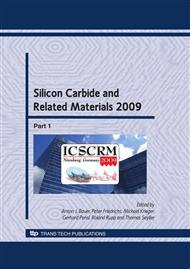p.277
p.283
p.287
p.291
p.295
p.299
p.303
p.307
p.311
Nucleation of c-Axis Screw Dislocations at Substrate Surface Damage during 4H-Silicon Carbide Homo-Epitaxy
Abstract:
Observations of dislocation nucleation occurring at substrate surface scratches during 4H-SiC CVD homoepitaxial growth are reported. Sub-surface residual damage associated with the scratches is observed to act as nucleation sites for basal plane dislocations (BPDs), threading edge dislocations (TEDs) and threading screw dislocations (TSDs) in the epilayer. TEDs and BPDs replicate from the surface intersections of basal plane dislocation half-loops injected into the substrate surface. A model for the nucleation mechanism of TSDs, which nucleate in opposite sign pairs, is presented which involves overgrowth of surface indentations associated with the scratch during step flow growth. Atomic steps which approach these local surface indentations can collapse creating pairs of opposite sign screw dislocations which have Burgers vector magnitude equal to the magnitude of the step disregistry created during the collapse.
Info:
Periodical:
Pages:
295-298
Citation:
Online since:
April 2010
Authors:
Price:
Сopyright:
© 2010 Trans Tech Publications Ltd. All Rights Reserved
Share:
Citation:


